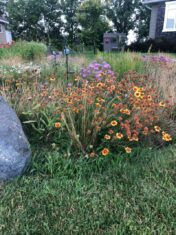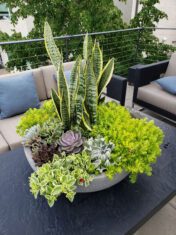
In my “very late” summer garden, the aristocratic purple-leaved cimicifugas are in heavy bud and the first Japanese anemones are just beginning to flower. Together with fall asters and ‘Arendsii’ monkshood, these perennials will usher me smoothly from the end of summer through autumn, and will form the floral backbone of the garden until the first killing frosts. But in my gardener’s heart of hearts, of all these beautiful flowers, I will always have a particularly soft spot for cimicifugas.
Cimicifuga (Actaea simplex [Atropurpurea Group] cultivars)
Due to their almost instant popularity, it feels as if cimicifugas have always been part of the gardener’s late season arsenal, but until 25 years ago, they were almost unknown in Canadian gardens. Since then, cimicifugas have joined that rather exclusive club of perennials that flower in early autumn, giving exhausted gardens a much needed shot in the arm.
Thanks to the introduction of the Danish-bred cultivar ‘Brunette’ in the late 1980s, cimicifugas quickly found themselves in the horticultural limelight. ‘Brunette’ was the first variety to produce reliably purple-brown foliage, and gardeners soon realized that with its dark, fern-like leaves, the plant had ornamental qualities for three seasons instead of just one. ‘Brunette’ was the first cultivar in a new wave of purple-leaved cimicifugas that would come to be known as the Atropurpurea Group.
But no sooner had gardeners learned how to pronounce “cimicifuga” than British botanist James Compton upset the entire apple cart: After conducting DNA tests in 1998, Dr. Compton asserted that the genus Cimicifuga should be moved into Actaea, and for once, taxonomists around the world swiftly accepted the change. Several new species were created, and “cimicifuga” morphed into a common name, ousting old, unflattering epithets such as baneberry, bugbane and snakeroot.
James Compton grew up at Newby Hall, North Yorkshire, the scion of a horticulturally precocious family whose combined botanical enthusiasm is evident everywhere at the family home: There are more than 25 acres (10 ha) of gardens at Newby, including one of Europe’s largest double herbaceous borders as well as what is arguably the most comprehensive collection of dogwoods in the world. The house itself was designed by Sir Christopher Wren with interiors by Robert Adam and furnishings by Chippendale. Puff, puff.
When I visited Newby, I was fortunate enough to be shown around “the park” by James Compton’s younger brother Richard. At one point we rounded a blind corner, and there, spread before us was a huge border devoted exclusively to cimicifugas of every shape and size. “This is where my brother putters about” Richard explained. Hundreds of cimicifuga flower spikes shimmered and waved in the early autumn breeze, releasing the intoxicating fragrance of ripe grapes mixed with jasmine.
Now, 10 years later with my feet planted firmly back on Canadian soil, I grow four of what I consider to be the crème de la crème of the Actaea simplex Atropurpurea Group hybrids. I still have my original ‘Brunette’ — partly because as a brand spanking new “brag plant” it was staggeringly expensive when I bought it — $50 in 1995. But in the Summer of Canada’s 150th, gardeners can purchase the same plant for about $15, proving once and for all that patience is a virtue.
Cimicifuga ‘Black Negligee’ was introduced shortly afterwards; it boasts gorgeous purple-black foliage that frames its fragrant, creamy white bottle-brush flowers to perfection. Robust ‘Hillside Black Beauty’ (introduced in 1997) bears almost-black leaves and was discovered as a chance seedling by horticulturist Mary Ann McGourty at Hillside Gardens, Connecticut. But by far, the most floriferous cultivar I grow is ‘James Compton’ with its purple-bronze foliage and one-foot (30-cm)-long racemes of grape bubblegum-scented flowers. Named after its hybridizer, its blooms always remind me of my botanically inspiring weekend at Newby Hall.
Cimicifugas attract butterflies and bees, they have no serious disease or insect pests and are deer and rabbit resistant. Hardy to Zone 3, they grow best in moist, rich loam in a partly shaded site. Atropurpurea Group cultivars grow about 40 inches (100 cm) tall by 20 inches (50 cm) wide and rarely — if ever — need to be divided (once planted, cimicifugas resent disturbance). Most modern cultivars are a cosmopolitan mix of species and cultivars derived from both North American and Eurasian sources.
Slow growing and statuesque, cimicifugas may be planted in early autumn or spring, and are guaranteed to add a touch of patrician elegance to your late season borders.









I love your garden, your flower garden is beautiful. Your article is great, give me a lot of information and admire your garden.
I too love having cimicifugas in my Zone 3 shade garden. I have had Actaea ‘Brunette’ and ‘Pink Spires’ for many years. Both of them grow very well and are the perfect flowering perennial for the late summer/fall garden. In the summer I often use their lovely dark green leaves in bouquets bringing great depth to the flowers. The perfume is intoxicating and a huge extra bonus for this ‘must have’ perennial.
I have ‘Brunette’and just adore its looks and fragrance. The planting in full sun flowers far better than the one with more shade, and I believe, all other things being equal!
By the time I had learned to pronounce cimicifuga and remember it the plant became actea!
No matter, the aroma alone is worth the purchase!
Ah Plant Lust, Stephen! I too paid an outrageous price for my first one. Fell in love and expanded to other cultivars as they became available/I was able to source. I do have 4 Pink Spikes lining the front walkway for the past 4 years. I believe it is a z.4 cultivar and living in z. 3, NWO, it struggles. 2 appear to be established and 2 will likely not make it. I winter cover with straw. But the deep colour of the foliage and the pink of the spires makes the effort worthwhile. Last year, for the first time, the deer decided, “why not”. (Everything else gets Deer Stopper). So they are now on the spray list.
Nothing warms a gardeners heart during fall cleanup like looking up at those beauties waving in the wind and filled with buzzing bees. Thanks for the great article!
Thanks for posting this, it is a plant that I am not familiar with, so as I have a shade garden, I will look for it.
I have been growing cimicifugas since 1985. James Compton was my first one, and was called Actea ‘James Compton’. The came ‘Brunette’, ‘Hillside Black Beauty’, ‘Black Negligee’ and ‘Pink Spike’, which at the time were called cimicifugas. Of course the taxonomists got into the act, and now they are all Actea. I believe it had something to do with the fleshiness of the seed pods. I am always on the lookout for a new one – they add a huge amount of drama to the shade gardens. I wouldn’t be without it.
I bought a Actaea simplex ‘White Pearl’ this spring. I think I’ll add some of the ones you mentioned to my Plants Wanted List! Thanks for the recommendations.